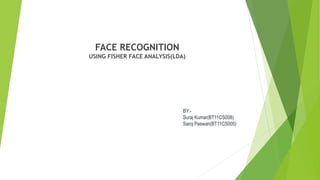This document discusses face recognition using Fisher face analysis (LDA). It provides an overview of LDA and how it is used for face recognition. LDA works by finding a linear transformation that maximizes between-class variance and minimizes within-class variance to achieve better class separation. The document outlines the LDA algorithm which involves computing within-class and between-class scatter matrices to find discriminant vectors that project faces into a space where classes are well separated. It also mentions the ORL face database is used and provides references for further information.

















![The subspace for LDA is spanned by a set of vectors w=[푎 푚, 푏푚, …,
ℎ푚], Satisfying
w = arg max = mod
푤푇 푆푏 푤
푤푇 푆푤 푤
-----(3)
The with-in class scatter matrix represents how face images are distributed
closely with-in classes and between class scatter matrix describes how
classes are separated from each other. When face images are projected into
the discriminant vector w.
Face images should be distributed closely with-in classes and should
be separated between classes, as much as possible. In other words, these
discriminant vectors minimize the denominator and maximize the
numerator in equation (3).](https://image.slidesharecdn.com/lda-141030063047-conversion-gate01/85/Lda-18-320.jpg)


![REFERENCES
[1] [Online]. Available:
http://www.animetrics.com/technology/frapplications.html
http://en.wikipedia.org/wiki/Facial_recognition_system
http://vis-www.cs.umass.edu/~vidit/IndianFaceDatabase
http://www.originlab.com
[2] B. J. Oh, Face Recognition using Radial Basis Function Network based on
LDA. World Academy of Science, Engineering and Technology 7 2005
[3] R. Duda and P. Hart, Pattern Classification and Scene Analysis.
[4] R. Chellappa, C. Wilson, and S. Sirohey, Human and Machine Recognition
of Faces: A Survey, Proc. IEEE, vol. 83, no. 5, pp. 705- 740, 1995.
[5] ORL face database: AT &T Laboratories, Cambridge,U.K..[Online].
Available: http://www. cam-orl.co.uk / facedatabse.html.](https://image.slidesharecdn.com/lda-141030063047-conversion-gate01/85/Lda-21-320.jpg)
